Electrochemical Determination of Tryptophan Based on Gly@CDs Clusters Modified Glassy Carbon Electrode
Abstract
:1. Introduction
2. Materials and Methods
2.1. General Remarks
2.2. Bottom-Up Electrochemical Synthesis of CDs under Constant Current Conditions from CH3CH2OH
2.3. Functionalization with Glycine of CDs from EtOH
2.4. Electrochemical Characterization
2.5. Electrochemical Analysis
2.6. HPLC-ESI-MS in SIR Mode Analysis
3. Results and Discussion
3.1. Gly@CDs Synthesis and Characterization
3.2. Carbon Dots in Tryptophan Electrochemical Sensors
3.3. Electrochemical Characterization of Gly@CDs-GCE
3.4. Electro-Oxidation Performance of Trp at Gly@CDs-GCE
4. Conclusions
Author Contributions
Funding
Institutional Review Board Statement
Informed Consent Statement
Data Availability Statement
Acknowledgments
Conflicts of Interest
References
- Moulaee, K.; Neri, G. Electrochemical Amino Acid Sensing: A Review on Challenges and Achievements. Biosensors 2021, 11, 502. [Google Scholar] [CrossRef] [PubMed]
- Kalzuna-Czaplinska, J.; Gatarek, P.; Chirumbolo, S.; Stanley Chartrand, M.; Bjørklund, G. How important is tryptophan in human health? Crit. Rev. Food Sci. Nutr. 2019, 59, 72–88. [Google Scholar] [CrossRef] [PubMed]
- Wang, H.; Jiang, S.; Pan, J.; Lin, J.; Wang, J.; Li, M.; Xie, A.; Luo, S. Nanomaterials-based electrochemical sensors for the detection of natural antioxidants in food and biological samples: Research progress. Microchim. Acta 2022, 189, 318. [Google Scholar] [CrossRef] [PubMed]
- Rejithamol, R.; Krishnan, R.G.; Beena, S. Disposable pencil graphite electrode decorated with a thin film of electro-polymerized 2, 3, 4, 6, 7, 8, 9, 10-octahydropyrimido [1, 2-a] azepine for simultaneous voltammetric analysis of dopamine, serotonin and tryptophan. Mater. Chem. Phys. 2021, 258, 123857. [Google Scholar] [CrossRef]
- Roy, P.; Chen, P.-C.; Periasamy, A.P.; Chen, Y.-N.; Chang, H.-T. Photoluminescent carbon nanodots: Synthesis, physicochemical properties and analytical applications. Mater. Today 2015, 18, 447–458. [Google Scholar] [CrossRef]
- Barman, M.K.; Patra, A. Current status and prospects on chemical structure driven photoluminescence behaviour of carbon dots. J. Photochem. Photobiol. C Photochem. Rev. 2018, 37, 1–22. [Google Scholar] [CrossRef]
- Sharma, A.; Das, J. Small molecules derived carbon dots: Synthesis and applications in sensing, catalysis, imaging, and biomedicine. J. Nanobiotechnol. 2019, 17, 92. [Google Scholar] [CrossRef] [PubMed]
- Yao, B.; Huang, H.; Liu, Y.; Kang, Z. Carbon Dots: A Small Conundrum. Trends Chem. 2019, 1, 235–246. [Google Scholar] [CrossRef]
- Sturabotti, E.; Camilli, A.; Moldoveanu, V.G.; Bonincontro, G.; Simonetti, G.; Valletta, A.; Serangeli, I.; Miranda, E.; Amato, F.; Marrani, A.G.; et al. Targeting the Antifungal Activity of Carbon Dots against Candida albicans Biofilm Formation by Tailoring Their Surface Functional Groups. Chem. Eur. J. 2024, 30, e202303631. [Google Scholar] [CrossRef]
- Wang, X.; Feng, Y.; Dong, P.; Huang, J. A Mini Review on Carbon Quantum Dots: Preparation, Properties, and Electrocatalytic Application. Front. Chem. Sec. Catal. Photocatal. 2019, 7, 671. [Google Scholar] [CrossRef]
- Yu, J.; Song, H.; Li, X.; Tang, L.; Tang, Z.; Yang, B.; Lu, S. Computational Studies on Carbon Dots Electrocatalysis: A Review. Adv. Funct. Mater. 2021, 31, 2107196. [Google Scholar] [CrossRef]
- Cui, L.; Ren, X.; Sun, M.; Liu, H.; Xia, L. Carbon Dots: Synthesis, Properties and Applications. Nanomaterials 2021, 11, 3419. [Google Scholar] [CrossRef] [PubMed]
- Bortolami, M.; Bogles, I.I.; Bombelli, C.; Pandolfi, F.; Feroci, M.; Vetica, F. Electrochemical Bottom-Up Synthesis of Chiral Carbon Dots from L-Proline and Their Application as Nano-Organocatalysts in a Stereoselective Aldol Reaction. Molecules 2022, 27, 5150. [Google Scholar] [CrossRef] [PubMed]
- Bortolami, M.; Rocco, D.; Simonis, B.; Feroci, M.; Vetica, F. Organocatalyzed Mannich reaction: Electrochemically synthesized prolinated carbon dots vs. prolinated graphene oxide. Synth. Commun. 2023, 53, 1647–1663. [Google Scholar] [CrossRef]
- Zulfajri, M.; Sudewi, S.; Ismulyati, S.; Rasool, A.; Adlim, M.; Huang, G.G. Carbon Dot/Polymer Composites with Various Precursors and Their Sensing Applications: A Review. Coatings 2021, 11, 1100. [Google Scholar] [CrossRef]
- Di Matteo, P.; Trani, A.; Bortolami, M.; Feroci, M.; Petrucci, R.; Curulli, A. Electrochemical Sensing Platform Based on Carbon Dots for the Simultaneous Determination of Theophylline and Caffeine in Tea. Sensors 2023, 23, 7731. [Google Scholar] [CrossRef] [PubMed]
- The Nobel Prize in Chemistry. Available online: https://www.nobelprize.org/prizes/chemistry/ (accessed on 25 June 2024).
- Rocco, D.; Moldoveanu, V.G.; Feroci, M.; Bortolami, M.; Vetica, F. Electrochemical Synthesis of Carbon Quantum Dots. ChemElectroChem 2023, 10, e202201104. [Google Scholar] [CrossRef] [PubMed]
- Xia, C.; Zhu, S.; Feng, T.; Yang, M.; Yang, B. Evolution and Synthesis of Carbon Dots: From Carbon Dots to Carbonized Polymer Dots. Adv. Sci. 2019, 6, 1901316. [Google Scholar] [CrossRef] [PubMed]
- Imanzadeh, H.; Sefid-Sefidehkhan, Y.; Afshary, H.; Afruz, A.; Amiri, M. Nanomaterial-based electrochemical sensors for detection of amino acids. J. Pharm. Biomed. Anal. 2023, 230, 115390. [Google Scholar] [CrossRef]
- Gautam, J.; Raj, M.; Goyal, R.N. Determination of Tryptophan at Carbon Nanomaterials Modified Glassy Carbon Sensors: A Comparison. J. Electrochem. Soc. 2020, 167, 066504. [Google Scholar] [CrossRef]
- Hassanvand, Z.; Jalali, F.; Nazari, M.; Parnianchi, F.; Santoro, C. Carbon Nanodots in Electrochemical Sensors and Biosensors: A Review. ChemElectroChem 2021, 8, 15–35. [Google Scholar] [CrossRef]
- Chen, J.; He, P.; Bai, H.; He, S.; Zhang, T.; Zhang, X.; Dong, F. Poly(β-cyclodextrin)/carbon quantum dots modified glassy carbon electrode: Preparation, characterization and simultaneous electrochemical determination of dopamine, uric acid and tryptophan. Sens. Actuators B 2017, 252, 9–16. [Google Scholar] [CrossRef]
- Wang, Z.; An, R.; Dai, Y.; Luo, H. A Simple Strategy for the Simultaneous Determination of Dopamine, Uric Acid, L-Tryptophan and Theophylline Based on a Carbon Dots Modified Electrode. Int. J. Electrochem. Sci. 2021, 16, 210450. [Google Scholar] [CrossRef]
- Abdel-aal, F.A.M.; Kamel, R.M.; Abdeltawab, A.A.; Mohamed, F.A.; Mohamed, A.-M.I. Polypyrrole/carbon dot nanocomposite as an electrochemical biosensor for liquid biopsy analysis of tryptophan in the human serum of normal and breast cancer women. Anal. Bioanal. Chem. 2023, 415, 4985–5001. [Google Scholar] [CrossRef] [PubMed]
- Tian, R.; Zhi, J. Fabrication and electrochemical properties of boron-doped diamond film–gold nanoparticle array hybrid electrode. Electrochem. Commun. 2007, 9, 1120–1126. [Google Scholar] [CrossRef]
- Dekanski, A.; Stevanovic, J.; Stevanovic, R.; Nikolic, B.Z. Glassy carbon electrodes I. Characterization and electrochemical activation. Carbon 2001, 39, 1195–1205. [Google Scholar] [CrossRef]
- Mocak, J.; Bond, A.M.; Mitchell, S.; Scollary, G. A statistical overview of standard (IUPAC and ACS) and new procedures for determining the limits of detection and quantification: Application to voltammetric and stripping techniques. Pure Appl. Chem. 1997, 69, 297–328. [Google Scholar] [CrossRef]
- Bortolami, M.; Di Matteo, P.; Rocco, D.; Feroci, M.; Petrucci, R. Metabolic Profile of Agropyron repens (L.) P. Beauv. Rhizome Herbal Tea by HPLC-PDA-ESI-MS/MS Analysis. Molecules 2022, 27, 4962. [Google Scholar] [CrossRef] [PubMed]
- Strohmeier, M.; Alderman, D.W.; Grant, D.M. Obtaining Molecular and Structural Information from 13C-14N Systems with 13C FIREMAT Experiments. J. Magn. Res. 2002, 155, 263–277. [Google Scholar] [CrossRef]
- Murphy, K.R. A Note on Determining the Extent of the Water Raman Peak in Fluorescence Spectroscopy. Appl. Spectrosc. 2011, 65, 233–236. [Google Scholar] [CrossRef]
- Vázquez-Nakagawa, M.; Rodríguez-Pérez, L.; Martín, N.; Ángeles Herranz, M. Supramolecular Assembly of Edge Functionalized Top-Down Chiral Graphene Quantum Dots. Angew. Chem. Int. Ed. 2022, 61, e202211365. [Google Scholar] [CrossRef] [PubMed]
- Li, D.; Han, D.; Qu, S.-N.; Liu, L.; Jing, P.-T.; Zhou, D.; Ji, W.-Y.; Wang, X.-Y.; Zhang, T.-F.; Shen, D.-Z. Supra-(carbon nanodots) with a strong visible to near-infrared absorption band and efficient photothermal conversion. Light Sci. Appl. 2016, 5, e16120. [Google Scholar] [CrossRef] [PubMed]
- Li, D.; Qu, Y.; Zhang, Y.; Zheng, W.; Rogach, A.L.; Qu, S. Supra-(carbon dots) with versatile morphologies and promising optical properties. Chem. Eng. J. 2023, 454, 140069. [Google Scholar] [CrossRef]
- Bard, A.J.; Faulkner, L.R. Electrochemical Methods Fundamentals and Application; John Wiley & Sons: New York, NY, USA, 2001. [Google Scholar]
- Nguyen, N.T.; Wrona, M.Z.; Dryhurst, G. Electrochemical oxidation of tryptophan. J. Electroanal. Chem. 1986, 199, 101–126. [Google Scholar] [CrossRef]
- Wopschall, R.H.; Shain, I. Effects of adsorption of electroactive species in stationary electrode polarography. Anal. Chem. 1967, 39, 1514–1527. [Google Scholar] [CrossRef]
- Mattioli, I.A.; Baccarin, M.; Cervini, P.; Cavalheiro, E.T.G. Electrochemical investigation of a graphite-polyurethane composite electrode modified with electrodeposited gold nanoparticles in the voltammetric determination of tryptophan. J. Electroanal. Chem. 2019, 835, 212–219. [Google Scholar] [CrossRef]
- Qian, J.; Yang, J.; Zhang, Y.; Zeng, T.; Wan, Q.; Yang, N. Interfacial superassembly of flower-like NiMn-LDH@poly-L-lysine composites for selective electrochemical sensing of tryptophan. Anal. Chim. Acta 2023, 1237, 340608. [Google Scholar] [CrossRef] [PubMed]
- Foroughi, M.M.; Jahani, S.; Rashidi, S. Simultaneous detection of ascorbic acid, dopamine, acetaminophen and tryptophan using a screen-printed electrode modified with woolen ball-shaped La3+/TiO2 nanostructure as a quadruplet nanosensor. Microchem. J. 2024, 198, 110156. [Google Scholar] [CrossRef]
- Kodakat, K.; Sam, S.; Kumar, K.G. A Poly(L-Arginine)-Based Electrochemical Sensor for Simultaneous Determination of Uric Acid, Tryptophan, and Hypoxanthine. J. Electrochem. Soc. 2024, 171, 017509. [Google Scholar] [CrossRef]
- Zhang, R.; Tan, Z.-C.; Huang, K.-C.; Wen, Y.; Li, X.-Y.; Zhao, J.-L.; Liu, C.-L. A Vortex-Assisted Dispersive Liquid-Liquid Microextraction Followed by UPLC-MS/MS for Simultaneous Determination of Pesticides and Aflatoxins in Herbal Tea. Molecules 2019, 24, 1029. [Google Scholar] [CrossRef]


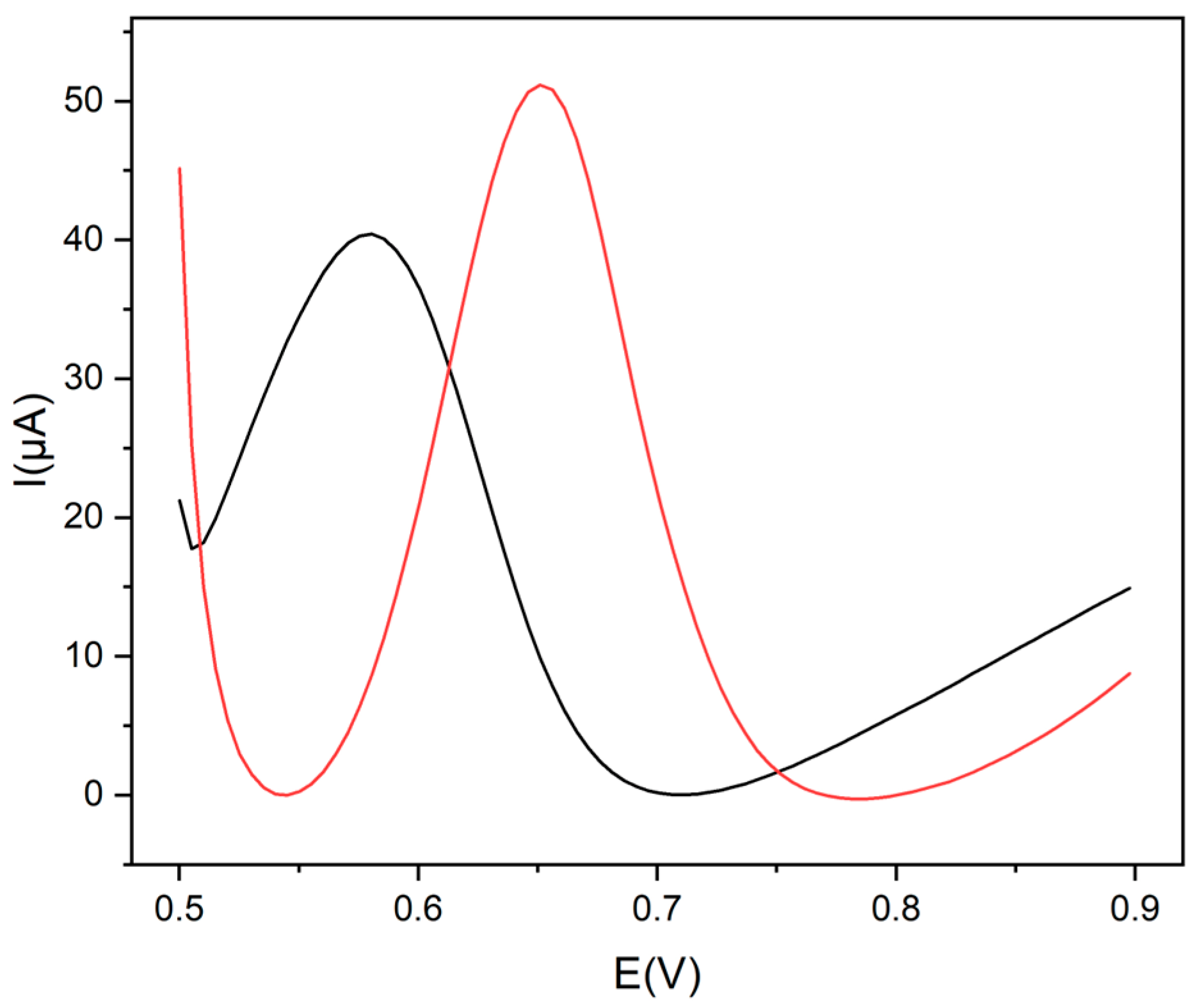

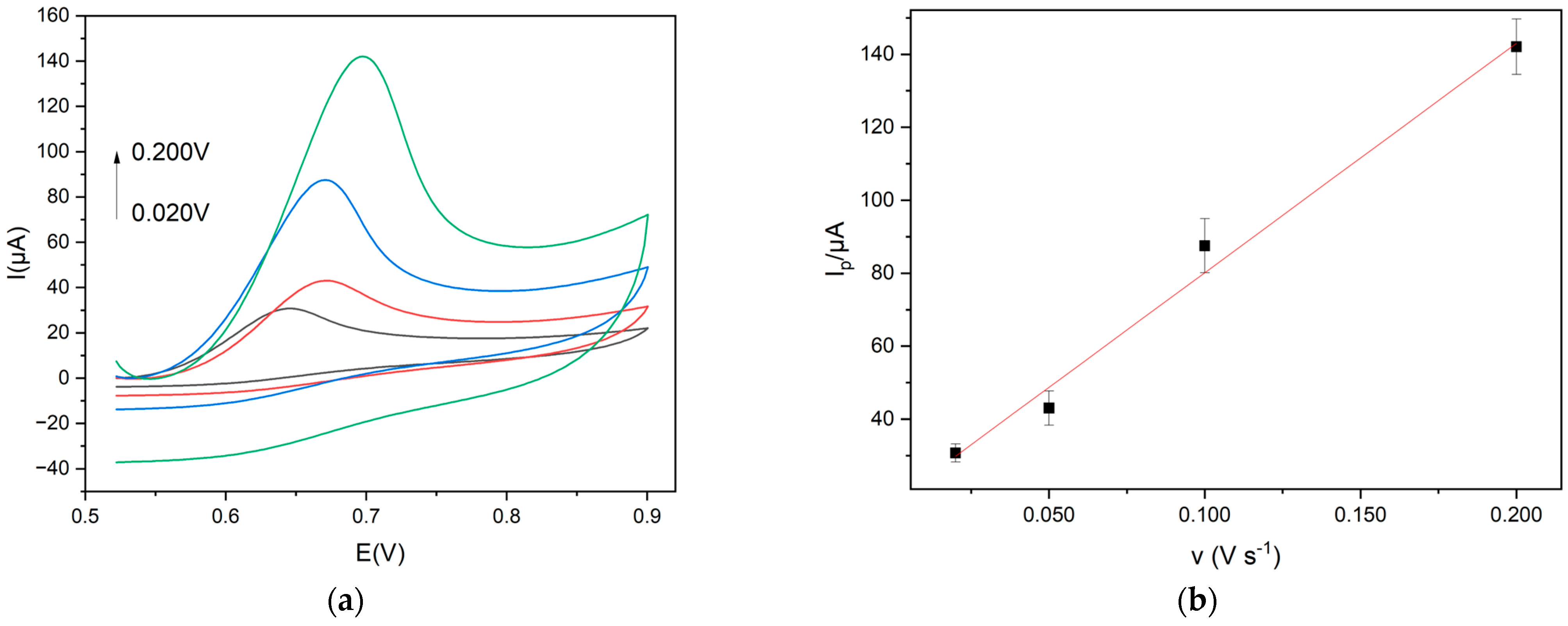
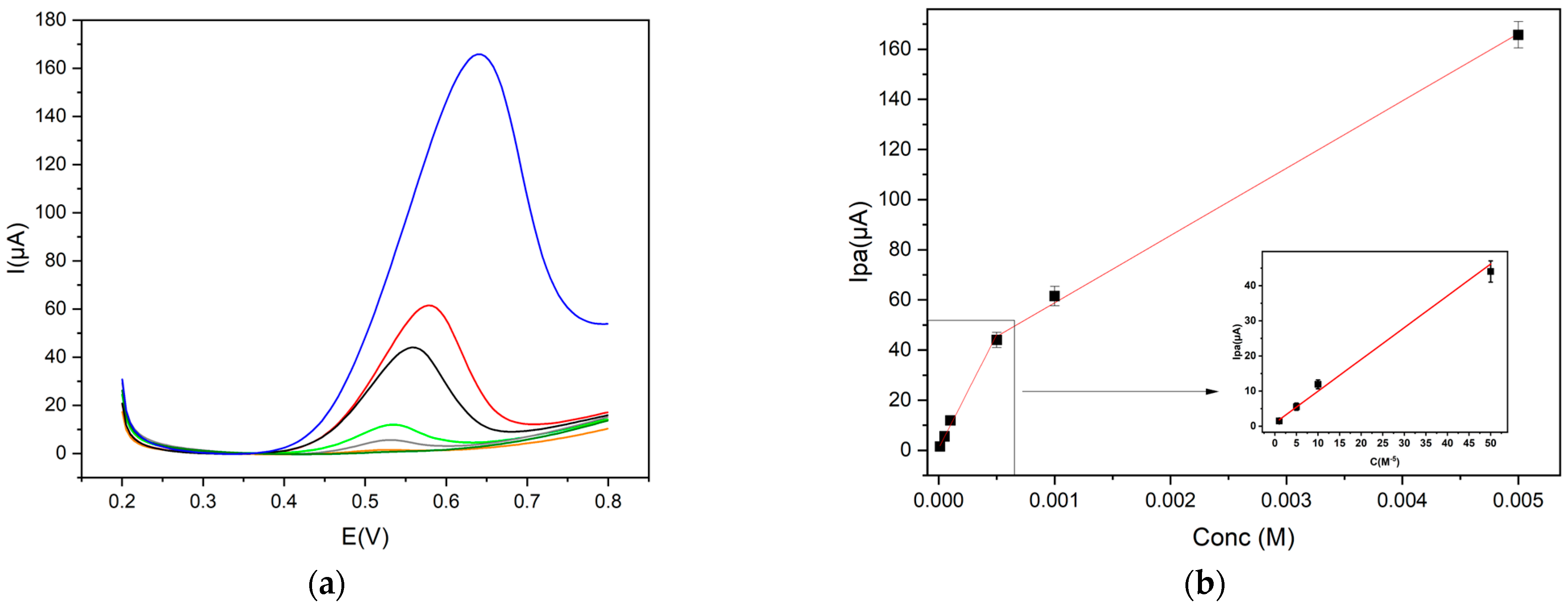
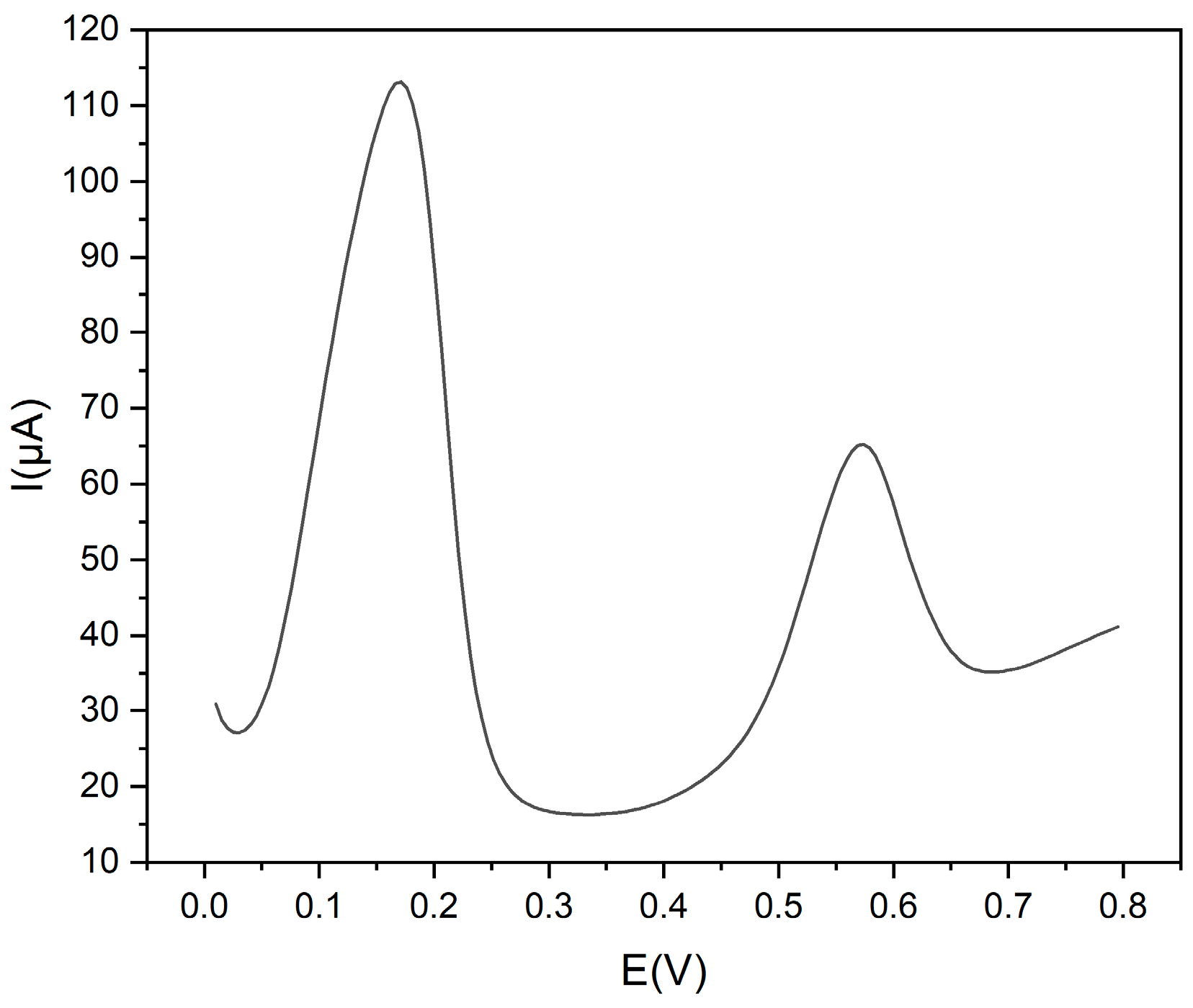
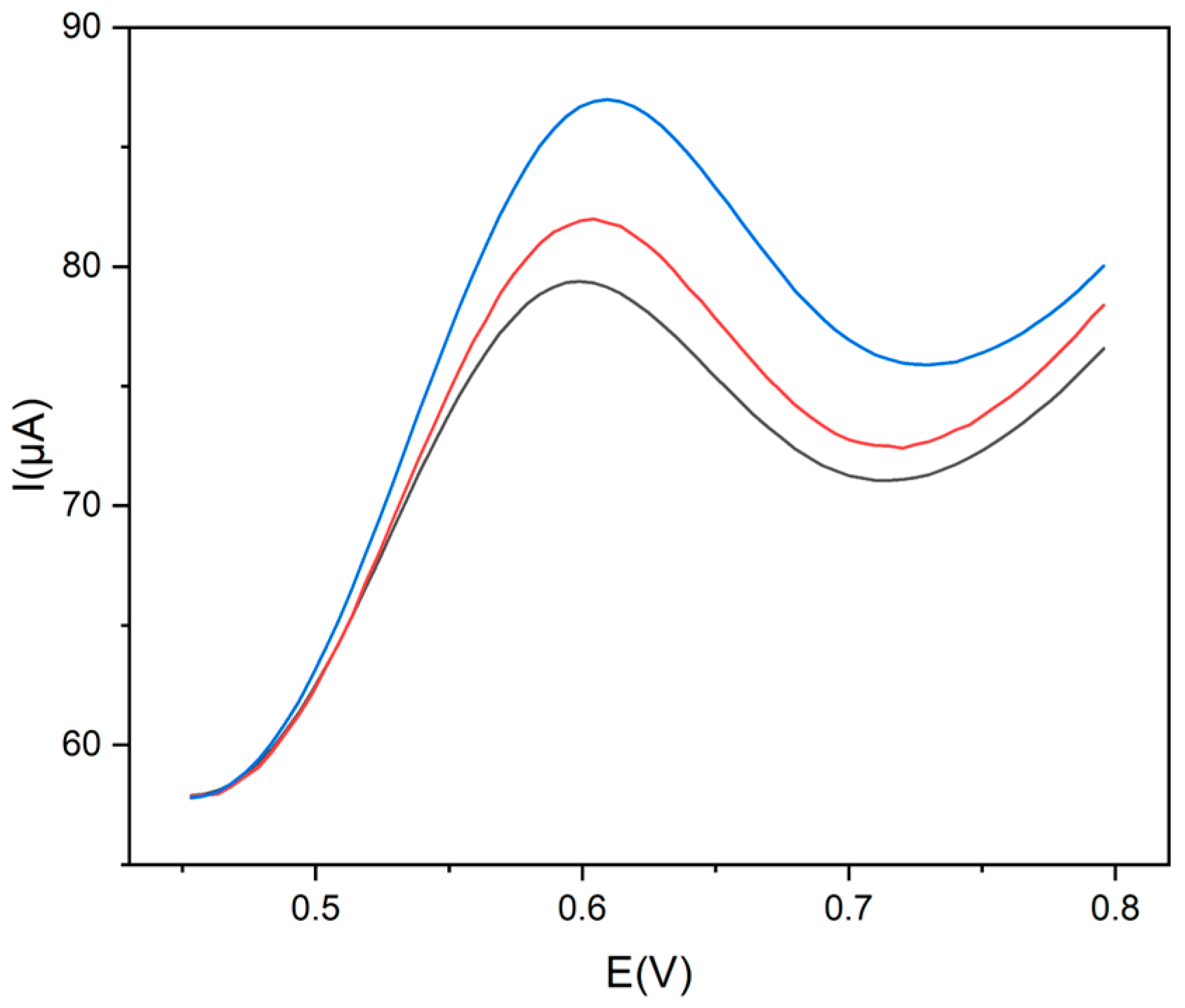
| Bare Electrode (GCE) | Eap (V) | Iap (μA) | Modified GCE (Gly@CDs-GCE) | Eap (V) | ΔEap (V) | Iap (μA) | ΔIap (%) |
|---|---|---|---|---|---|---|---|
| pH 3 | 0.829 | 2.43 | pH 3 | 0.834 | 0.005 | 10.05 | 313 |
| pH 5 | 0.744 | 30.27 | pH 5 | 0.741 | −0.003 | 30.59 | 1.05 |
| pH 7 | 0.675 | 12.72 | pH 7 | 0.690 | 0.015 | 15.43 | 21.3 |
| pH 9 | 0.609 | 14.31 | pH 9 | 0.641 | 0.032 | 23.71 | 65.70 |
| Electrode | Technique | Linearity (mol L−1) | LOD (mol L−1) | Application | Ref. |
|---|---|---|---|---|---|
| AuNPs/EGPU | DPV | 2.0 × 10−6–1.0 × 10−5 | 5.3 × 10−8 | Urine, pharmaceutical formulation | [38] |
| NiMn-LDH@PLL/GCE | DPV | 0.1 × 10−6–1.3 × 10−4 | 5.3 × 10−8 | Urine, pharmaceutical formulation | [39] |
| WB-S La3+/TiO2-NS/SPE | DPV | 1.0 × 10−7–9.0 × 10−4 | 8.4 × 10−8 | Pharmaceutical formulation | [40] |
| p-Arg/GCE | SWV | 6.0 × 10−7–6.0 × 10−5 | 4.4 × 10−8 | Dietary Supplement | [41] |
| Gly@CDs-GCE | DPV | 5.0 × 10−6–5.0 × 10−3 | 5.0 × 10−6 | Dietary Supplement, herbal tea | This work |
Disclaimer/Publisher’s Note: The statements, opinions and data contained in all publications are solely those of the individual author(s) and contributor(s) and not of MDPI and/or the editor(s). MDPI and/or the editor(s) disclaim responsibility for any injury to people or property resulting from any ideas, methods, instructions or products referred to in the content. |
© 2024 by the authors. Licensee MDPI, Basel, Switzerland. This article is an open access article distributed under the terms and conditions of the Creative Commons Attribution (CC BY) license (https://creativecommons.org/licenses/by/4.0/).
Share and Cite
Bortolami, M.; Di Matteo, P.; Mastrorilli, P.; Petrucci, R.; Trani, A.; Vetica, F.; Feroci, M.; Curulli, A. Electrochemical Determination of Tryptophan Based on Gly@CDs Clusters Modified Glassy Carbon Electrode. Chemosensors 2024, 12, 149. https://doi.org/10.3390/chemosensors12080149
Bortolami M, Di Matteo P, Mastrorilli P, Petrucci R, Trani A, Vetica F, Feroci M, Curulli A. Electrochemical Determination of Tryptophan Based on Gly@CDs Clusters Modified Glassy Carbon Electrode. Chemosensors. 2024; 12(8):149. https://doi.org/10.3390/chemosensors12080149
Chicago/Turabian StyleBortolami, Martina, Paola Di Matteo, Piero Mastrorilli, Rita Petrucci, Alessandro Trani, Fabrizio Vetica, Marta Feroci, and Antonella Curulli. 2024. "Electrochemical Determination of Tryptophan Based on Gly@CDs Clusters Modified Glassy Carbon Electrode" Chemosensors 12, no. 8: 149. https://doi.org/10.3390/chemosensors12080149






